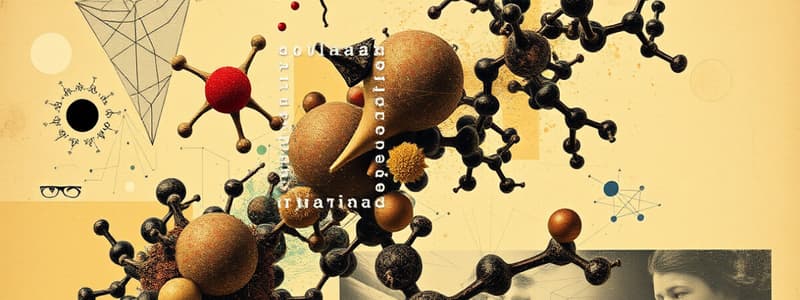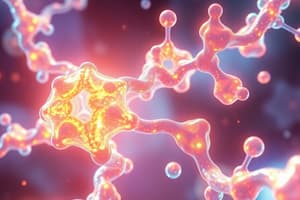Podcast
Questions and Answers
What class does glycogen belong to?
What class does glycogen belong to?
Carbohydrate
What class does cholesterol belong to?
What class does cholesterol belong to?
Lipid
What class does RNA belong to?
What class does RNA belong to?
Nucleic acid
What class does collagen belong to?
What class does collagen belong to?
What class does hemoglobin belong to?
What class does hemoglobin belong to?
What class does a gene belong to?
What class does a gene belong to?
What class does a triacylglyceride belong to?
What class does a triacylglyceride belong to?
What class does an enzyme belong to?
What class does an enzyme belong to?
What class does cellulose belong to?
What class does cellulose belong to?
What class does chitin belong to?
What class does chitin belong to?
What does polymerization mean?
What does polymerization mean?
What is one way that disaccharides can't differ?
What is one way that disaccharides can't differ?
What happens when a protein denatures?
What happens when a protein denatures?
What stabilizes an alpha helix and where is it commonly found?
What stabilizes an alpha helix and where is it commonly found?
The fatty acid formula C16H32O2 is...
The fatty acid formula C16H32O2 is...
How can you identify if a fatty acid is saturated?
How can you identify if a fatty acid is saturated?
What are beta pleated sheets characterized by?
What are beta pleated sheets characterized by?
What are the four classes of large molecules?
What are the four classes of large molecules?
What three of the four classes are considered macromolecules?
What three of the four classes are considered macromolecules?
What is a macromolecule?
What is a macromolecule?
What is a polymer?
What is a polymer?
What is a monomer?
What is a monomer?
What type of reaction connects monomers?
What type of reaction connects monomers?
What occurs in a dehydration reaction?
What occurs in a dehydration reaction?
What type of reaction breaks apart polymers?
What type of reaction breaks apart polymers?
How do you determine the amount of water molecules released after a dehydration reaction?
How do you determine the amount of water molecules released after a dehydration reaction?
In this equation which side does the water molecule go? C6H12O6 + C6H12O6 = C12H22O21
In this equation which side does the water molecule go? C6H12O6 + C6H12O6 = C12H22O21
Is glucose a monomer or a polymer?
Is glucose a monomer or a polymer?
What are the monomers of carbohydrates?
What are the monomers of carbohydrates?
What are most monosaccharides a multiple of?
What are most monosaccharides a multiple of?
With the new models, how are carbons usually represented?
With the new models, how are carbons usually represented?
What are three examples of a disaccharide?
What are three examples of a disaccharide?
What are the two monosaccharides of sucrose?
What are the two monosaccharides of sucrose?
Where is sucrose found?
Where is sucrose found?
What two monosaccharides make up maltose?
What two monosaccharides make up maltose?
Where is maltose found?
Where is maltose found?
What two monosaccharides make up lactose?
What two monosaccharides make up lactose?
Where is lactose found?
Where is lactose found?
What does the root word -ose mean?
What does the root word -ose mean?
What is a glycosidic linkage?
What is a glycosidic linkage?
What are the two types of polysaccharides?
What are the two types of polysaccharides?
What are two examples of energy storage polysaccharides?
What are two examples of energy storage polysaccharides?
What are two examples of structural polysaccharides?
What are two examples of structural polysaccharides?
Why can't we digest cellulose?
Why can't we digest cellulose?
Study Notes
Classes of Biological Macromolecules
- Glycogen is classified as a carbohydrate.
- Cholesterol belongs to the lipid class.
- RNA and genes are classified as nucleic acids.
- Collagen and hemoglobin are proteins.
- Triacylglycerides are lipids, while cellulose and chitin classify as carbohydrates.
- Enzymes are also proteins.
Polymerization and Structure
- Polymerization is the process of creating or breaking apart polymers.
- Disaccharides differ in the number of monosaccharides.
- Protein denaturation disrupts secondary and tertiary structures due to broken hydrogen bonds.
- Alpha helices are stabilized by hydrogen bonds and commonly found in fibrous proteins.
- Beta pleated sheets are characterized by folds stabilized by hydrogen bonds between polypeptide segments.
Macromolecules and Their Building Blocks
- Four main classes of large molecules: carbohydrates, proteins, lipids, and nucleic acids.
- Three of these classes (carbohydrates, proteins, nucleic acids) are considered macromolecules.
- Macromolecules are large molecules consisting of smaller units.
- Polymers are complex structures made up of subunits known as monomers.
Reactions Involving Monomers and Polymers
- Dehydration reactions connect monomers, removing H and OH to form water.
- Hydrolysis reactions break apart polymers.
- The number of water molecules released in dehydration reactions equals the number of subunits minus one.
- In the reaction involving glucose, water appears on the right side of the equation.
Monosaccharides and Disaccharides
- Glucose serves as a monomer, while the monomer of carbohydrates is monosaccharides.
- Most monosaccharides are multiples of CH2O.
- Disaccharides include sucrose, maltose, and lactose, each formed from specific monosaccharides.
- Sucrose consists of glucose and fructose, commonly found in table sugar.
- Maltose is made of two glucose units, found in malt sugar or beer.
- Lactose consists of glucose and galactose, primarily found in milk.
- The suffix -ose indicates a sugar.
Carbohydrate Linkages and Polysaccharides
- Glycosidic linkages are covalent bonds between monosaccharides formed via dehydration reactions.
- Two polysaccharide types are energy storage and structural.
- Starch (amylose) and glycogen serve as energy storage polysaccharides.
- Cellulose and chitin are examples of structural polysaccharides.
- Humans cannot digest cellulose due to the inability of enzymes to hydrolyze its beta linkages, caused by structural differences.
Studying That Suits You
Use AI to generate personalized quizzes and flashcards to suit your learning preferences.
Description
Test your knowledge on key biological macromolecules with this set of flashcards covering chapters 3 to 5 of AP Biology. Learn about carbohydrates, lipids, nucleic acids, and proteins through definitional questions that challenge your understanding of their classifications.



